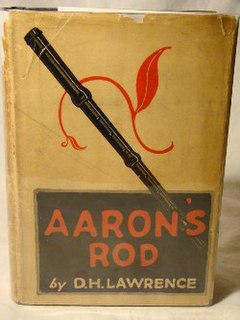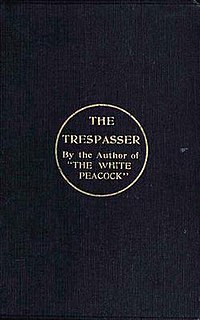 W
WAaron's Rod is a picaresque novel by D. H. Lawrence, started in 1918 and published in 1922.
 W
WThe Boy in the Bush is a novel by D. H. Lawrence set in Western Australia, first published in 1924. It is derived from a story in a manuscript given to Lawrence by Mollie Skinner, entitled The House of Ellis. Lawrence and his wife Frieda stayed with Skinner at her guesthouse in Darlington, Western Australia in 1922.
 W
WThe Escaped Cock is a short novel by D. H. Lawrence that he originally wrote in two parts and published in 1929. Lawrence wrote the first part in 1927 after visiting some Etruscan tombs with his friend Earl Brewster, a trip that encouraged the author to reflect upon death and myths of resurrection. He added the second part in 1928 during a stay in Gstaad, Switzerland.
 W
WKangaroo is a 1923 novel by D.H. Lawrence. It is set in Australia.
 W
WLady Chatterley's Lover is a novel by English author D. H. Lawrence, first published privately in 1928 in Italy and in 1929 in France. An unexpurgated edition was not published openly in the United Kingdom until 1960, when it was the subject of a watershed obscenity trial against the publisher Penguin Books. Penguin won the case and quickly sold three million copies. The book was also banned for obscenity in the United States, Canada, Australia, India, and Japan. The book soon became notorious for its story of the physical relationship between a working-class man and an upper-class woman, its explicit descriptions of sex, and its use of then-unprintable four-letter words.
 W
WThe Lost Girl is a novel by D. H. Lawrence, first published in 1920. It was awarded the 1920 James Tait Black Memorial Prize in the fiction category. Lawrence started it shortly after writing Women in Love, and worked on it only sporadically until he completed it in 1920.
 W
WMr Noon is an unfinished novel by the English writer D. H. Lawrence. It appears to have been drafted in 1920 and 1921 and then abandoned by the author. It consists of two parts.
 W
WThe Plumed Serpent is a 1926 political novel by D. H. Lawrence; Lawrence conceived the idea for the novel while visiting Mexico in 1923, and its themes reflect his experiences there. The novel was first published by Martin Secker's firm in the United Kingdom and Alfred A. Knopf in the United States; an early draft was published as Quetzalcoatl by Black Swan Books in 1995. The novel's plot concerns Kate Leslie, an Irish tourist who visits Mexico after the Mexican Revolution. She encounters Don Cipriano, a Mexican general who supports a religious movement, the Men of Quetzalcoatl, founded by his friend Don Ramón Carrasco. Within this movement, Cipriano is identified with Huitzilopochtli and Ramón with Quetzalcoatl. Kate eventually agrees to marry Cipriano, while the Men of Quetzalcoatl, with the help of a new President, bring about an end to Christianity in Mexico, replacing it with Quetzalcoatl worship.
 W
WThe Rainbow is a novel by British author D. H. Lawrence, first published by Methuen & Co. in 1915. It follows three generations of the Brangwen family living in Nottinghamshire, particularly focusing on the individual's struggle to growth and fulfilment within the confining strictures of English social life. Lawrence's 1920 novel Women in Love is a sequel to The Rainbow.
 W
WSons and Lovers is a 1913 novel by the English writer D. H. Lawrence, originally published by Gerald Duckworth and Company Ltd., London, and Mitchell Kennerley Publishers, New York. While the novel initially received a lukewarm critical reception, along with allegations of obscenity, it is today regarded as a masterpiece by many critics and is often regarded as Lawrence's finest achievement.
 W
WThe Trespasser is a 1912 novel by D. H. Lawrence. Originally it was titled the Saga of Siegmund and drew upon the experiences of a friend of Lawrence, Helen Corke, and her adulterous relationship with a married man that ended with his suicide. Lawrence worked from Corke's diary, with her permission, but also urged her to publish; which she did in 1933 as Neutral Ground.
 W
WThe White Peacock is the first novel by D. H. Lawrence, published in 1911, though with 1910 on the title page. Lawrence started the novel in 1906 and then rewrote it three times. The early versions had the working title of Laetitia.
 W
WWomen in Love (1920) is a novel by British author D. H. Lawrence. It is a sequel to his earlier novel The Rainbow (1915), and follows the continuing loves and lives of the Brangwen sisters, Gudrun and Ursula. Gudrun Brangwen, an artist, pursues a destructive relationship with Gerald Crich, an industrialist. Lawrence contrasts this pair with the love that develops between Ursula Brangwen and Rupert Birkin, an alienated intellectual who articulates many opinions associated with the author. The emotional relationships thus established are given further depth and tension by an intense psychological and physical attraction between Gerald and Rupert. The novel ranges over the whole of British society before the time of the First World War and eventually concludes in the snows of the Tyrolean Alps. Ursula's character draws on Lawrence's wife Frieda and Gudrun's on Katherine Mansfield, while Rupert Birkin's has elements of Lawrence himself, and Gerald Crich is partly based on Mansfield's husband, John Middleton Murry.